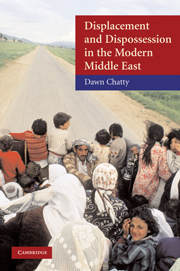Book contents
- Frontmatter
- Contents
- List of Tables
- List of Charts and Maps
- Acknowledgements
- Introduction: Dispossession and Forced Migration in the Middle East: Community Cohesion in Impermanent Landscapes
- 1 Dispossession and Displacement within the Contemporary Middle East: An Overview of Theories and Concepts
- 2 Dispossession and Forced Migration in the Late Ottoman Empire: Distinct Cultures and Separated Communities
- 3 Circassian, Chechnyan, and Other Muslim Communities Expelled from the Caucasus and the Balkans
- 4 The Armenians and Other Christians: Expulsions and Massacres
- 5 Palestinian Dispossession and Exodus
- 6 Kurds: Dispossessed and Made Stateless
- 7 Liminality and Belonging: Social Cohesion in Impermanent Landscapes
- Bibliography
- Index
6 - Kurds: Dispossessed and Made Stateless
Published online by Cambridge University Press: 05 June 2012
- Frontmatter
- Contents
- List of Tables
- List of Charts and Maps
- Acknowledgements
- Introduction: Dispossession and Forced Migration in the Middle East: Community Cohesion in Impermanent Landscapes
- 1 Dispossession and Displacement within the Contemporary Middle East: An Overview of Theories and Concepts
- 2 Dispossession and Forced Migration in the Late Ottoman Empire: Distinct Cultures and Separated Communities
- 3 Circassian, Chechnyan, and Other Muslim Communities Expelled from the Caucasus and the Balkans
- 4 The Armenians and Other Christians: Expulsions and Massacres
- 5 Palestinian Dispossession and Exodus
- 6 Kurds: Dispossessed and Made Stateless
- 7 Liminality and Belonging: Social Cohesion in Impermanent Landscapes
- Bibliography
- Index
Summary
I was born in 1920 in Turkey in a village near Mardin. My father's family included 400–500 young men. We came here [to Syria] in 1925. The French were in Syria. They offered us shelter and were very good to us. We were tyrannized by the Turks who were against all Islamic teachings. The Turks were not true Muslims. They wanted us to assimilate. They wanted to force all the people in the villages to wear hats [this is a reference to Mustafa Kemal's efforts to get Western dress adopted by all Turks]. We fled after the revolution led by Shaykh Said in 1920. The Kurds revolted against the Turks. They demanded a self-governed Kurdish state in Turkey. When Shaykh Said was hung by the Turks, many Kurds fled Turkey and came to Syria. I remember we all travelled in big groups, seven or eight families and all of their sheep and cattle which they sold on the way at Ras al-‘Ain. We all walked to Dayr al-Zor and then to Al-Sham [Damascus]. We had relatives here who received us and helped us to settle. This quarter had only Kurds who spoke Kurdish. What is funny was that when my father left Turkey, he had no idea there were other people than Kurds in the world. He was quite shocked when he got to Dayr al-Zor and heard people talking other languages. He used to say that he almost turned back there to return to Turkey. When we had been in Syria for six or five years we were granted citizenship [by the French mandate authority]. […]
- Type
- Chapter
- Information
- Displacement and Dispossession in the Modern Middle East , pp. 231 - 278Publisher: Cambridge University PressPrint publication year: 2010
- 1
- Cited by



